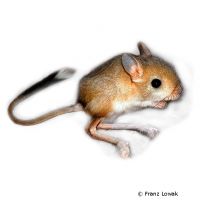Lesser Egyptian Jerboa (Jaculus jaculus)
| Lesser Egyptian Jerboa Jaculus jaculus | |
|---|---|
| Name | Lesser Egyptian Jerboa |
| Name Lat. | Jaculus jaculus |
| Family | Dipodids |
| Family lat. | Dipodidae |
| Order | Rodents |
| Order lat. | Rodentia |
| Origin | Africa, Asia |
| Climate | Subtropical - tropical |
| Habitat | Semi-desert, steppe |
| Diet | Seeds, green fodder, insects |
| Behavior | Nocturnal; territorial |
| Keeping | Pair, group |
| Care Level | Moderate |
| Life Span | 4-6 years |
| Protection | No |
| Metric Units | |
| Size | 12 cm |
| Temperature | 22-26 °C |
| Housing | A: 1 m² / H: 0.8 m |
| US Units | |
| Size | 4.7" |
| Temperature | 72-79 °F |
| Housing | 10 ft² / 30" hight |
Distribution and habitat
Predominantly crepuscular and nocturnal, lesser desert jumping mice are widely distributed from North Africa through the Arabian Peninsula to southwestern Iran. They inhabit deserts, semi-deserts, dry steppes and dry grasslands, where they live in self-dug burrows.
Maintenance
Minimum dimensions for the enclosure:
| 1-2 animals | area: 1 m² | Height: 0.8 m |
| Each additional animal | Area: + 20 |
A terrarium placed in a bright (no direct sunlight), draught-free and quiet place is recommended, with ventilation openings on the sides, and it must not be tightly closed at the top. The enclosure should be structured with rocks, roots and branches, with plenty of open space for them to run. They need hiding and sheltering places (rodent houses, clay tubes, clay caves, etc.), food and drinking containers, a sand bath (chinchilla sand) for grooming, nesting material (hay, animal hair) and a substrate for digging. Sand or a sand-earth mixture is suitable as a substrate, which is covered with some bark mulch and dry leaves. The bedding depth should be 10 cm. For the wear of their teeth must always be available nail material, such as untreated twigs and branches of fruit trees, as well as a rodent stone
| temperature day: 22-26 °C | temperature night: 18-20 °C |
A heat mat (floor heater) under the container is recommended. Light sources that also produce the necessary heat are ideal. A natural day-night rhythm must be ensured.
Diet
The species-specific food supply consists of a low-fat grain mixture, such as the budgie food available in specialist shops, and grass seed, supplemented with millet, which also serves as an occupation, feed hay, some fresh food (wild herbs, root vegetables) and a mineral stone. Especially for rearing young, they need animal protein that varies from individual to individual, such as insects (crickets, meal beetle larvae, etc.), cottage cheese, a hard-boiled hen's egg, or insect food. Fruit should rarely be offered in very small quantities. A shallow clay bowl is better than a nipple waterer. Drinking water must always be available and, like food, should be offered fresh daily.
A varied diet promotes health and prevents deficiency symptoms.
Behaviour and compatibility
They are sociable animals and should be kept in pairs. If the enclosure size is appropriate and if each animal has its own shelter, keeping them in groups is also possible. At the first signs of incompatibility, the animals should be separated immediately.
Reproduction and breeding
In the male, the anal and genital openings are farther apart than in the female.
The pregnant female should be placed separately from the male in a separate container where she will raise the young without disturbance. The gestation period is 23-25 days. A litter usually consists of 1-4 young, which are born naked, blind and deaf. After about 2 months, the young are independent and the mother can be placed back with the male. Young are sexually mature after 8-12 months. Life expectancy is 5-6 years.
Important
They normally move lightly hopping or on all fours, only using their powerful jumping legs when escaping
A sunny place irradiated with a heat lamp (spot) is gladly visited.
As escape animals they need sufficient retreat and hiding places, therefore the enclosure should also be somewhat elevated and not placed on the floor
They should not be grabbed or pulled by the tail, as the skin can easily tear and detach. Better than by hand they can be caught with a landing net or by lifting the animals out together with their sleeping cave.
Lighting and heat radiators should be placed in such a way as to prevent injury to the animals. Special attention should be paid to thorough hygiene and contamination should be removed regularly.
Further literature can be found in your pet store.
References
Text: petdata; Image: Franz Lowak
Source: W. PUSCHMANN, D. ZSCHEILE, K. ZSCHEILE (2009): Zootierhaltung - Tiere in menschlicher Obhut: Säugetiere, Harri Deutsch Verlag; EHRLICH (2006): Kleinsäuger im Terrarium, Natur und Tierverlag; BMEL (2014): Gutachten über Mindestanforderungen an die Haltung von Säugetieren
- Gemäß § 21 Abs. 5 Tierschutzgesetz idgF
